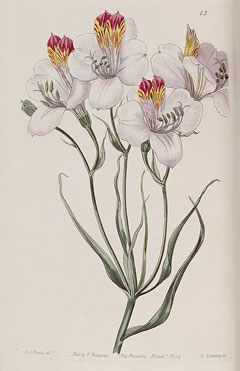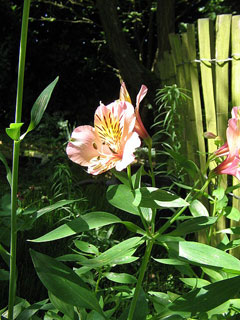 |
|
http://commons.wikimedia.org/wiki/File:Alstroemeria_ligtu_Edwards's_25.13.1839.jpg |
 |
| http://commons.wikimedia.org/wiki/User:Meneerke_bloem |
Translate this page:
Summary
Alstroemeria lilies, native to South America, are suitable for cut flowers. Often given on Valentine's Day they have long lasting attractive flowers that represent friendship and devotion. The root can be eaten once cooked. The roots are a source of a palatable starch and are very nutritious.
Physical Characteristics

 Alstroemeria ligtu is a PERENNIAL growing to 0.6 m (2ft) by 1 m (3ft 3in) at a medium rate.
Alstroemeria ligtu is a PERENNIAL growing to 0.6 m (2ft) by 1 m (3ft 3in) at a medium rate.
See above for USDA hardiness. It is hardy to UK zone 8 and is not frost tender. It is in leaf from February to August, in flower in July, and the seeds ripen in August. The species is hermaphrodite (has both male and female organs).
Suitable for: light (sandy) and medium (loamy) soils and prefers well-drained soil. Suitable pH: mildly acid, neutral and basic (mildly alkaline) soils. It can grow in semi-shade (light woodland) or no shade. It prefers dry or moist soil and can tolerate drought. The plant can tolerate maritime exposure.
UK Hardiness Map
US Hardiness Map
Synonyms
Plant Habitats
Cultivated Beds;
Edible Uses
Edible Parts: Root
Edible Uses:
Root - cooked[105]. The roots are a source of a palatable starch[2, 46, 177]. It is very nutritious and is given to children and invalids[139].
References More on Edible Uses
Medicinal Uses
Plants For A Future can not take any responsibility for any adverse effects from the use of plants. Always seek advice from a professional before using a plant medicinally.
None known
References More on Medicinal Uses
The Bookshop: Edible Plant Books
Our Latest books on Perennial Plants For Food Forests and Permaculture Gardens in paperback or digital formats.

Edible Tropical Plants
Food Forest Plants for Hotter Conditions: 250+ Plants For Tropical Food Forests & Permaculture Gardens.
More

Edible Temperate Plants
Plants for Your Food Forest: 500 Plants for Temperate Food Forests & Permaculture Gardens.
More

More Books
PFAF have eight books available in paperback and digital formats. Browse the shop for more information.
Shop Now
Other Uses
References More on Other Uses
Cultivation details
Landscape Uses:Border, Container, Massing. Requires a fertile, moisture retentive well-drained soil and a warm situation in sun or semi-shade[200]. Prefers a dry sheltered border and a peaty loam[1]. Established plants are drought tolerant according to one report[190], whilst another says that the soil should not be allowed to dry out in the growing season[42]. Plants succeed in maritime gardens[233]. A very ornamental plant[1], it is not hardy in the colder areas of the country, tolerating temperatures down to between -5 to -10°c[200]. Young plants are best given a protective mulch for their first winter or two[233]. The lily-like flowers have a sweet fragrance of mignonette[245]. They are one of the longest-lasting of cut flowers for the home and so are commonly grown for this purpose[245]. The edible roots are sold in local markets in Chile[46]. The roots should be planted 15 - 20cm deep when dormant in late summer to autumn and then be well mulched to protect them from severe winter weather. Plants can be rather invasive, spreading by means of underground fleshy roots to form large patches[187]. Somewhat intolerant of root disturbance[1], the roots are fleshy and brittle[200]. Special Features:Suitable for cut flowers, Attractive flowers or blooms. Bloom Color: Lavender, Pink, Purple, Red, White, Yellow. Form: Rounded.
References Carbon Farming Information and Carbon Sequestration Information
Temperature Converter
Type a value in the Celsius field to convert the value to Fahrenheit:
Fahrenheit:
The PFAF Bookshop
Plants For A Future have a number of books available in paperback and digital form. Book titles include Edible Plants, Edible Perennials, Edible Trees,Edible Shrubs, Woodland Gardening, and Temperate Food Forest Plants. Our new book is Food Forest Plants For Hotter Conditions (Tropical and Sub-Tropical).
Shop Now
Plant Propagation
Seed - best sown in individual pots in a cold frame as soon as it is ripe although seedlings can be transplanted successfully if they are moved with care whilst small. Pre-soak stored seed for 12 hrs in warm water, warm stratify for 4 weeks at 25°c and then reduce the temperature to 10°c. Excising a small bit of the seed near the embryo after the seed has been warm stratified helps to speed up the germination process[164]. Plant out about 20cm deep into their permanent positions in late summer or autumn[200]. Division in April or October with care since the plant resents root disturbance[133]. Ensure each portion has a growth bud[111].
Other Names
If available other names are mentioned here
Native Range
SOUTHERN AMERICA: Chile (Biobío, Maule, Libertador General Bernardo O Higgins, Región Metropolitana de Santiago, Valparaíso)
Weed Potential
Right plant wrong place. We are currently updating this section.
Please note that a plant may be invasive in one area but may not in your area so it's worth checking.
Conservation Status
IUCN Red List of Threatened Plants Status :

Growth: S = slow M = medium F = fast. Soil: L = light (sandy) M = medium H = heavy (clay). pH: A = acid N = neutral B = basic (alkaline). Shade: F = full shade S = semi-shade N = no shade. Moisture: D = dry M = Moist We = wet Wa = water.
Now available:
Food Forest Plants for Mediterranean Conditions
350+ Perennial Plants For Mediterranean and Drier Food Forests and Permaculture Gardens.
[Paperback and eBook]
This is the third in Plants For A Future's series of plant guides for food forests tailored to
specific climate zones. Following volumes on temperate and tropical ecosystems, this book focuses
on species suited to Mediterranean conditions—regions with hot, dry summers and cool, wet winters,
often facing the added challenge of climate change.
Read More
Expert comment
Author
L.
Botanical References
200
Links / References
For a list of references used on this page please go here
Readers comment
| Add a comment |
|
If you have important information about this plant that may help other users please add a comment or link below. Only comments or links that are felt to be directly relevant to a plant will be included. If you think a comment/link or information contained on this page is inaccurate or misleading we would welcome your feedback at [email protected]. If you have questions about a plant please use the Forum on this website as we do not have the resources to answer questions ourselves.
* Please note: the comments by website users are not necessarily those held by PFAF and may give misleading or inaccurate information.
To leave a comment please Register or login here All comments need to be approved so will not appear immediately.
|
Subject : Alstroemeria ligtu
|
|
|
|